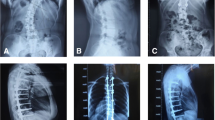Abstract
Background: Though adequate literature is present depicting the results of pedicle screw-rod instrumentation using top loading systems for correction of adolescent idiopathic scoliosis (AIS), using the rod rotation technique, few published data is available regarding side loading systems used for a similar purpose. We report a retrospective study of a cohort of patients with strict inclusion criteria who underwent surgical correction of AIS with side-opening pedicle screw-rod posterior instrumentation using the axial transaction technique of curve correction to assess the efficacy of side opening system for scoliosis correction with regards to patient satisfaction, Cobb’s angle correction and spinal balance.
Materials and Methods: Clinical and radiological outcomes were measured in 14 consecutive patients (3 males, 11 females) with an average age of 14.0 years (range 9 to 23 years). They were followed up for an average period of 13.0 months (range - 2.2 to 28.5). All patients underwent posterior instrumentation only with pedicle screws used as anchor points. Hybrid constructs using hooks/wires or curves requiring anterior release were excluded from the study. All levels were not instrumented - more screws were put on the concavity and in the peri-apical region. Radiological evaluation was done by whole spine standing AP, lateral radiograms preoperatively and 1, 3, 6 and12 months after surgery. Cobb’s angles were measured and the spinal balance was noted. Clinical evaluation was done by SRS questionnaire. The complications were documented.
Results: The mean preoperative Cobb’s angle was 58.35º (range - 44 to 72º), which came down postoperatively to 23.45º (range - 10 to 38º) signifying a mean correction of 59.57% (range - 26.92 to 76.17%). Clinical outcomes were evaluated using the SRS - 30 questionnaires. The values of mean pre- and postoperative scores are 3.68 and 4.18, showing an improvement of 0.5 points. Other than one patient of superficial wound infection, which healed with antibiotics, there was no major complication. No patient had neurological deterioration.
Conclusion: Side-opening spinal instrumentation systems, using the axial translation technique, achieved good clinical and radiological outcome for patients of AIS.
Similar content being viewed by others
References
Harrington PR. Treatment of scoliosis: Correction and internal fixation by spine instrumentation. J Bone Joint Surg Am 1962;44:591–610.
Luque ER. Segmental spinal instrumentation for correction of scoliosis. Clin Orthop Relat Res 1982;163:192–8.
Cotrel Y, Dubousset J, Guillaumat M. New universal instrumentation in spinal surgery. Clin Orthop Relat Res 1988;227:10–23.
Laxer E. A further development in spinal instrumentation: Technical Commission for Spinal Surgery of the ASIF. Eur Spine J 1994;3:347–52.
King HA, Moe JH, Bradford DS, Winter RB. The selection of fusion levels in thoracic idiopathic scoliosis. J Bone Joint Surg Am 1983;65:1302–13.
Asher MA, Min Lai S, Burton DC. Further development and validation of the Scoliosis Research Society (SRS) outcomes instrument. Spine 2000;25:2381–6.
Lehman RA Jr, Lenke LG, Keeler KA, Kim YJ, Buchowski JM, Cheh G, et al.. Operative treatment of adolescent idiopathic scoliosis with posterior pedicle screw-only constructs: Minimum three-year follow-up of one hundred fourteen cases. Spine (Phila Pa 1976) 2008;33:1598–604.
van Ooy A, Geukers CW. Results of CD operation in idiopathic scoliosis. Acta Orthop Belg 1992;58:129–33.
Kim YJ, Lenke LG, Kim J, Bridwell KH, Cho SK, Cheh G, et al.. Comparative analysis of pedicle screw versus hybrid instrumentation in posterior spinal fusion of adolescent idiopathic scoliosis. Spine (Phila Pa 1976) 2006;31:291–8.
Lonner BS, Auerbach JD, Boachie-Adjei O, Shah SA, Hosogane N, Newton PO. Treatment of thoracic scoliosis: Are monoaxial thoracic pedicle screws the best form of fixation for correction? Spine (Phila Pa 1976) 2009;34:845–51.
Ma WH, Sun SH, Xu RM, Ruan YP, Huang L, Ying JW, et al.. All pedicle screws technique applied to the treatment of idiopathic scoliosis. Zhongguo Gu Shang 2008;21:407–10.
Lee SM, Suk SI, Chung ER. Direct vertebral rotation: A new technique of three-dimensional deformity correction with segmental pedicle screw fixation in adolescent idiopathic scoliosis. Spine (Phila Pa 1976) 2004;29:343–9.
Vallespir GP, Flores JB, Trigueros IS, Sierra EH, Ferná ndez PD, Olaverri JC, et al.. Vertebral coplanar alignment: A standardized technique for three dimensional correction in scoliosis surgery: Technical description and preliminary results in Lenke type 1 curves. Spine (Phila Pa 1976) 2008;33:1588–97.
Di Silvestre M, Bakaloudis G, Lolli F, Vommaro F, Martikos K, Parisini P. Posterior fusion only for thoracic adolescent idiopathic scoliosis of more than 80°: Pedicle screws versus hybrid instrumentation. Eur Spine J 2008;17:1336–49.
Kuklo TR, Lenke LG, O’Brien MF, Lehman RA Jr, Polly DW Jr, Schroeder TM. Accuracy and efficacy of thoracic pedicle screws in curves more than 90°. Spine (Phila Pa 1976) 2005;30:222–6.
Author information
Authors and Affiliations
Corresponding author
Rights and permissions
About this article
Cite this article
Basu, S., Rathinavelu, S. & Baid, P. Posterior scoliosis correction for adolescent idiopathic scoliosis using side-opening pedicle screw-rod system utilizing the axial translation technique. IJOO 44, 42–49 (2010). https://doi.org/10.4103/0019-5413.58605
Published:
Issue Date:
DOI: https://doi.org/10.4103/0019-5413.58605




